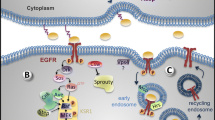Abstract
The Drosophila epidermal growth factor receptor (EGFR), functioning through the Ras/Raf/MAPK pathway, promotes cell proliferation and differentiation. Recent work has demonstrated that EGFR functions via the same Ras/Raf/MAPK pathway to promote cell survival. This review summarizes the role of EGFR in differentiation and survival during Drosophila eye development.
Similar content being viewed by others
References
Vojtek AB, Der CJ. Increasing complexity of the ras signaling pathway. J Biol Chem 1998; 273: 19925-19928.
Rommel C, Hafen E. Ras—a versatile cellular switch. Curr Opin Genet Dev 1998; 8: 412-418.
Schweitzer R, Shilo BZ. A thousand and one roles for the Drosophila EGF receptor. Trends Genet 1997; 13: 191-196.
Freeman M. Cell determination strategies in the Drosophila eye. Development 1997; 124: 261-270.
Kurada P, White K. Ras promotes cell survival in Drosophila by downregulating hid expression. Cell 1998; 95: 319-329.
Bergmann A, Agapite J, McCall K, Steller H. The Drosophila gene hid is a direct molecular target of Ras-dependent survival signaling. Cell 1998; 95: 331-341.
Dominguez M, Wasserman JD, Freeman M. Multiple functions of the EGF receptor in Drosophila eye development. Curr Biol 1998; 8: 1039-1048.
Dickson B, Hafen E. Genetic dissection of eye development in Drosophila. In: Bate M, Martinez Arias A, eds. The Development of Drosophila Melanogaster, Vol. II. New York: Cold Spring Harbor Laboratory Press, 1993: 1327-1362.
Karim FD, Rubin GM. Ectopic expression of activated Ras1 induces hyperplastic growth and increased cell death in Drosophila imaginal tissues. Development 1998; 125: 1-9.
Wolff T, Ready DF. Cell death in normal and rough eye mutants of Drosophila. Development 1991; 113: 825-839.
Xu T, Rubin GM. Analysis of genetic mosaics in developing and adult Drosophila tissues. Development 1993; 117: 1223-1237.
Freeman M. Reiterative use of the EGF receptor triggers differentiation of all cell types in the Drosophila eye. Cell 1996; 87: 651-660.
Banerjee U, Renfranz PJ, Pollock JA, Benzer S. Molecular characterization and expression of sevenless, a gene involved in neuronal pattern formation in the Drosophila eye. Cell 1987; 49: 281-291.
Hafen E, Basler K, Edstroem JE, Rubin GM. Sevenless, a cell-specific homeotic gene of Drosophila, encodes a putative transmembrane receptor with a tyrosine kinase domain. Science 1987; 236: 55-63.
Tio M, Moses K. The Drosophila TGF alpha homolog Spitz acts in photoreceptor recruitment in the developing retina. Development 1997; 124: 343-351.
Jarman AP, Grell EH, Ackerman L, Jan LY, Jan YN. Atonal is the proneural gene for Drosophila photoreceptors. Nature 1994; 369: 398-400.
Jarman AP, Sun Y, Jan LY, Jan YN. Role of the proneural gene, atonal, in formation of Drosophila chordotonal organs and photoreceptors. Development 1995; 121: 2019-2030.
Baker NE, Rubin GM. Effect on eye development of dominant mutations in Drosophila homologue of the EGF receptor. Nature 1989; 340: 150-153.
Lesokhin AM, Yu SY, Katz J, Baker NE. Several levels of EGF receptor signaling during photoreceptor specification in wildtype, Ellipse, and null mutant Drosophila. Dev Biol 1999; 205: 129-144.
Simon MA, Bowtell DD, Dodson GS, Laverty TR, Rubin GM. Ras1 and a putative guanine nucleotide exchange factor perform crucial steps in signaling by the sevenless protein tyrosine kinase. Cell 1991; 67: 701-716.
Brunner D, Oellers N, Szabad J, Biggs III WH, Zipursky SL, Hafen E. A gain-of-function mutation in Drosophila MAP kinase activates multiple receptor tyrosine kinase signaling pathways. Cell 1994; 76: 875-888.
Leevers SJ, Weinkove D, MacDougall LK, Hafen E, Waterfield MD. The Drosophila phosphoinositide 3-kinase Dp110 promotes cell growth. EMBO J 1996; 15: 6584-6594.
Diaz-Benjumea FJ, Hafen E. The sevenless signalling cassette mediates Drosophila EGF receptor function during epidermal development. Development 1994; 120: 569-578.
Baker NE, Rubin GM. Ellipse mutations in the Drosophila homologue of the EGF receptor affect pattern formation, cell division, and cell death in eye imaginal discs. Dev Biol 1992; 150: 381-396.
Sawamoto A, Taguchi A, Hirota Y, Yamada C, Jin M, Okano H. Argos induces programmed cell death in the developing Drosophila eye by inhibition of the ras pathway. Cell Death Differ 1998; 5: 262-270.
Rebay I, Rubin GM. Yan functions as a general inhibitor of differentiation and is negatively regulated by activation of the Ras1/MAPK pathway. Cell 1995; 81: 857-866.
Miller DT, Cagan RL. Local induction of patterning and programmed cell death in the developing Drosophila retina. Development 1998; 125: 2327-2335.
Grether ME, Abrams JM, Agapite J, White K, Steller H. The head involution defective gene of Drosophila melanogaster functions in programmed cell death. Genes Dev 1995; 9: 1694-1708.
White K, Grether ME, Abrams JM, Young L, Farrell K, Steller H. Genetic control of programmed cell death in Drosophila. Science 1994; 264: 677-683.
Zhou L, Schnitzler A, Agapite J, Schwartz LM, Steller H, Nambu JR. Cooperative functions of the reaper and head involution defective genes in the programmed cell death of Drosophila central nervous system midline cells. Proc Natl Acad Sci 1997; 94: 5131-5136.
Downward J. Ras signalling and apoptosis. Curr Opin Genet Dev 1998; 8: 49-54.
Staveley BE, Ruel L, Jin J, Stambolic V, et al. Genetic analysis of protein kinase B (AKT) in Drosophila. Curr Biol 1998; 8: 599-602.
Datta SR, Dudek H, Tao X, Masters S, Fu H, Gotoh Y, Greenberg ME. Akt phosphorylation of BAD couples survival signals to the cell-intrinsic death machinery. Cell 1997; 91: 231-241.
del Peso L, Gonzalez-Garcia M, Page C, Herrera R, Nunez G. Interleukin-3-induced phosphorylation of BAD through the protein kinase Akt. Science 1997; 278: 687-689.
Cardone MH, Roy N, Stennicke HR, et al. Regulation of cell death protease caspase-9 by phosphorylation. Science 1998; 282: 1318-1321.
Alessi DR, Cohen P. Mechanism of activation and function of protein kinase B. Curr Opin Genet Dev 1998; 8: 55-62.
Author information
Authors and Affiliations
Rights and permissions
About this article
Cite this article
Kurada, P., White, K. Epidermal growth factor receptor: its role in Drosophila eye differentiation and cell survival. Apoptosis 4, 239–243 (1999). https://doi.org/10.1023/A:1009648724937
Issue Date:
DOI: https://doi.org/10.1023/A:1009648724937




